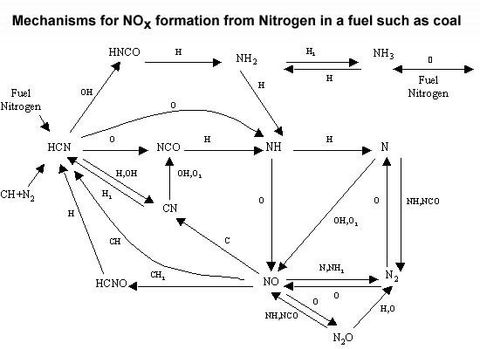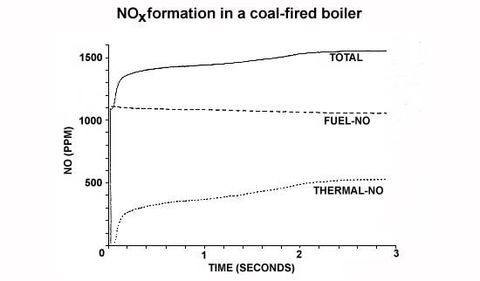NOx CHEMISTRY
MODELLING OF NITROGEN CHEMISTRY
Emissions of nitrogen oxides (NOx) are now of increasing importance in many combustion processes because of their effects on the environment, but their formation is complicated and not well understood. In the burning of coal for example, NOx may be formed by three different mechanisms; thermal, fuel and prompt. Much effort is therefore being placed on modifying the combustion process in order to reduce NOx formation.
Detailed models of NOx chemistry may include hundreds of reactions between many different species. The high-level input language of the FACSIMILE computer code enables these reactions to be specified in a simple and natural way, and then solved for both steady state and time dependent situations. The sensitivity analysis in FACSIMILE facilitates the identification of the most important reactions which is invaluable in developing reduced schemes.
In the Harwell Coal Combustion Programme, funded by the former Department of Energy (now part of the Department of Trade & Industry) as part of its Coal R&D Programme, a detailed model of NOx chemistry has been developed the current model consists of more than 230 reactions between 46 species and the governing equations are solved with FACSIMILE.
The detailed model has been validated using experimental data from a well-stirred flow reactor. In particular, it has been shown to predict the correct general behaviour for the dependence of NO formation on fuel/air stoichiometry in methane flames doped with various nitrogen compounds. The detailed model has been used to investigate the effects of temperature fluctuations and to evaluate simple models. Predictions with the simple model of de Soete, for example, vary significantly from the detailed model in fuel rich conditions, and so the simple model may not be valid in these conditions.
At the same time, NO formation in power station boilers has been predicted. Given the variation of the temperature and O2 through the boiler, and other information, the contributions of the thermal NO and fuel NO have been estimated, as shown in the adjacent figure.
Although the flow of fuel and oxidant has been treated simply as plug flow, the calculations provide a useful indication of the relative importance of the different routes to NO formation under boiler conditions.
The generation of a reduced model, for use with finite difference codes such as CFX-4 for modelling coal combustion, is one of the main costs of the current work and two different approaches are being followed.
A new sensitivity analysis has been developed at Harwell and incorporated in the FACSIMILE computer program. This enables coupled reactions to be analysed and the most important ones to be identified. In a parallel approach, the detailed mechanism is being represented by a 5-step lumped reaction scheme, which is an expanded but more fundamentally based form of the 2-step de Soete model. Such reduced models will lead to more accurate modelling of low NOx burners and better assessment of NOx reduction techniques in power station boilers.



